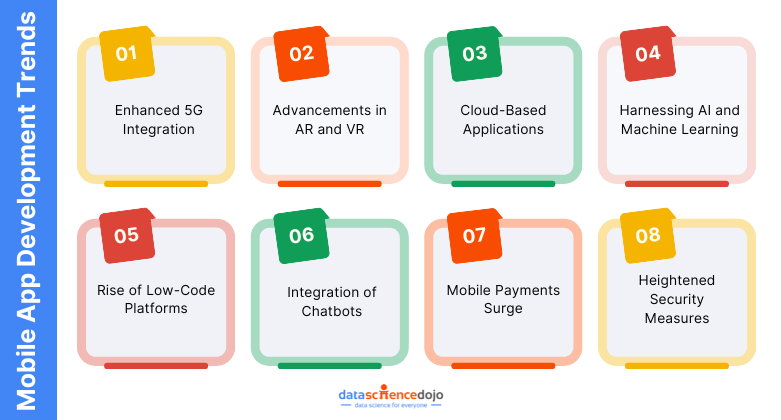The mobile app development industry is constantly evolving as smartphones become an integral part of our daily lives. Whether at work, home, or on vacation, our phones are always with us, making mobile apps a crucial tool for businesses to engage with potential customers.
The COVID-19 pandemic further cemented the smartphone’s role in our routines, enabling everything from grocery shopping and virtual classes to gaming, streaming, and telehealth appointments.
As a result, 2023 is shaping up to be a year of groundbreaking mobile app development trends. Emerging technologies like blockchain are enhancing secure payments, augmented reality is transforming education into an interactive experience, and on-demand apps are making essential services—like medication delivery—more accessible than ever.
With innovation at its core, the mobile app industry is set to redefine convenience and user experience in the years to come.
A Promising Future: Mobile App Revenue – As per reports by Statista, the total revenue earned from mobile apps is expected to grow at a rate of 9.27% from 2022 to 2026, with a projected market value of 614.40 billion U.S. Dollars by 2026.
What is Mobile App Technology?
Mobile app technology refers to the tools and methodologies used to create software applications for mobile devices like smartphones. These applications can be pre-installed or downloaded from app stores and are designed to provide users with specific functionalities.
Types of Mobile Applications
-
Native Apps: Developed specifically for a particular platform (iOS or Android), native apps utilize platform-specific programming languages—Swift or Objective-C for iOS, and Java or Kotlin for Android. This specialization allows them to fully leverage device features, resulting in optimal performance.
-
Cross-Platform Apps: These apps are designed to work across multiple platforms using a single codebase. Frameworks like React Native and Flutter enable developers to write code once and deploy it on both iOS and Android, streamlining the development process.
-
Hybrid Apps: Combining elements of native and web applications, hybrid apps are built using web technologies like HTML5, CSS, and JavaScript. They run within a native container, allowing them to function across different platforms while accessing device capabilities.
8 Mobile App Development Trends for 2023
In 2023, several key trends are shaping the future of mobile app development. From the rise of 5G technology and AI-driven solutions to the increasing adoption of cloud-based applications and enhanced security measures, these advancements are transforming how mobile apps are built and used.
Below we are going to explore the top eight mobile app development trends for 2023 that are set to redefine user experiences, improve operational efficiency, and drive business growth. Whether you are a developer, entrepreneur, or tech enthusiast, understanding these trends will help you stay ahead in the ever-evolving mobile ecosystem.
1. Enhanced 5G Integration:
The rise of 5G technology represents a pivotal milestone in the mobile app development landscape. This revolutionary advancement has unlocked a multitude of opportunities for app creators. With its remarkable speed and efficiency,
5G empowers developers to craft applications that are not only faster but also more data-intensive and reliable than ever before. As we enter 2025, it’s anticipated that developers will make substantial investments in harnessing 5G capabilities to elevate user experiences to unprecedented levels.
2. Advancements in AR and VR:
The dynamic field of mobile app development is witnessing a profound impact from the rapid advancements in Augmented Reality (AR) and Virtual Reality (VR) technologies. These cutting-edge innovations are taking center stage, offering users immersive and interactive experiences.
In the coming year, 2023, we can expect a surge in the adoption of AR and VR by app developers across a diverse range of devices. This trend will usher in a new era of app interactivity, allowing users to engage with digital elements within simulated environments.
Predictive analytics vs. AI: Why does the difference matter?
3. Cloud-based Applications:
The landscape of mobile app development is undergoing a significant transformation with the emergence of cloud-based applications. This evolution in methodology is gaining traction, and the year 2023 is poised to witness its widespread adoption.
Organizations are increasingly gravitating toward cloud-based apps due to their inherent scalability and cost-effectiveness. These applications offer the advantage of remote data accessibility, enabling streamlined operations, bolstered security, and the agility required to swiftly adapt to evolving requirements. This trend promises to shape the future of mobile app development by providing a robust foundation for innovation and responsiveness.
4. Harnessing AI and Machine Learning:
In the year 2023, the strategic utilization of AI (Artificial Intelligence) and machine learning stands as a game-changing trend, offering businesses a competitive edge. These cutting-edge technologies present an array of advantages, including accelerated development cycles, elevated user experiences, scalability to accommodate growth, precise data acquisition, and cost-effectiveness.
Moreover, they empower the automation of labor-intensive tasks such as testing and monitoring, thereby significantly contributing to operational efficiency.
5. Rise of Low-Code Platforms:
The imminent ascent of low-code platforms is poised to reshape the landscape of mobile app development by 2023. These platforms introduce a paradigm shift, simplifying the app development process substantially. They empower developers with limited coding expertise to swiftly and efficiently create applications.
This transformative trend aligns with the objectives of organizations aiming to streamline their operations and realize cost savings. It is expected to drive the proliferation of corporate mobile apps catering to diverse business needs.
6. Integration of Chatbots:
Chatbots are experiencing rapid expansion in their role within the realm of mobile app development. They excel at delivering personalized customer support and automating various tasks, such as order processing. In the year 2023, chatbots are poised to assume an even more pivotal role.
Companies are increasingly recognizing their potential in enhancing customer engagement and extracting valuable insights from customer interactions. As a result, the integration of chatbots will be a strategic imperative for businesses looking to stay ahead in the competitive landscape.
How to build and deploy a custom LLM application for your business
7. Mobile Payments Surge:
The year 2023 is poised to witness a substantial surge in the use of mobile payments, building upon the trend’s growing popularity in recent years. Mobile payments entail the seamless execution of financial transactions via smartphones or tablets, ushering in a convenient and secure era of digital transactions.
- Swift and Secure Transactions: Integrated mobile payment solutions empower users to swiftly and securely complete payments for goods and services. This transformative technology not only expedites financial transactions but also elevates operational efficiency across various sectors.
- Enhanced Customer Experiences: The adoption of mobile payments enhances customer experiences by eliminating the need for physical cash or credit cards. Users can conveniently make payments anytime, anywhere, contributing to a seamless and user-friendly interaction with businesses.
8. Heightened Security Measures:
In response to the escalating popularity of mobile apps, the year 2023 will witness an intensified focus on bolstering security measures. The growing demand for enhanced security is driven by factors such as the widespread use of mobile devices and the ever-evolving landscape of cybersecurity threats.
- Stricter Security Policies: Anticipate the implementation of more stringent security policies and safeguards to fortify the protection of user data and privacy. These measures will encompass a comprehensive approach to safeguarding sensitive information, mitigating risks, and ensuring a safe digital environment for users.
- Staying Ahead of Cyber Threats: Developers and organizations will be compelled to proactively stay ahead of emerging cyber threats. This proactive approach includes robust encryption, multi-factor authentication, regular security audits, and rapid response mechanisms to thwart potential security breaches.
Conclusion: Navigating the Mobile App Revolution of 2023
The mobile app industry is evolving rapidly, with businesses using innovative apps to engage users across e-commerce, education, and telehealth.
Blockchain enhances payment security, AR/VR revolutionizes experiences, and cloud technology boosts efficiency. AI and ML drive automation and personalization, while low-code platforms simplify development.
AI-powered chatbots improve customer service, and mobile payments grow with secure, contactless options. Stronger security measures like encryption and biometrics protect user data.
2023 is a year of innovation, making mobile apps more convenient, efficient, and impactful in shaping the future of technology.






